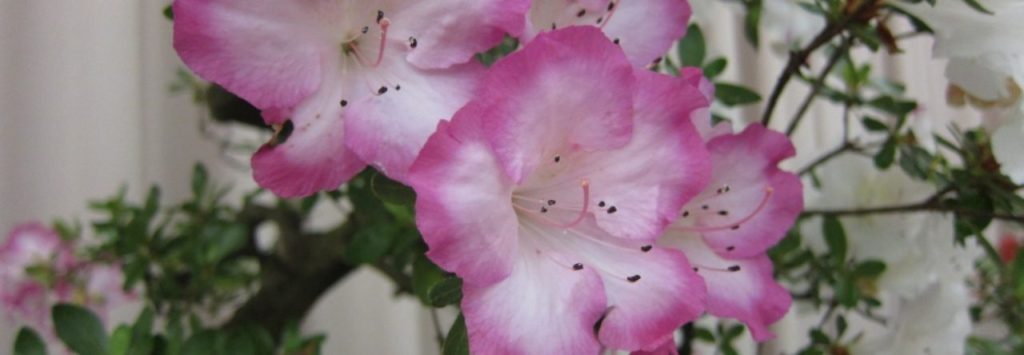Our September meeting provided a great “welcome back from Summer” program on pest and disease control for our satsuki azaleas, and suggestions for timely and appropriate feeding. Bob Gould, who so humbly insists he is not an expert, led our discussion and imparted tons of expert information. He brought several products to illustrate his preferred products and there was a lively back and forth with questions and suggestions from members. Darren Wong, who studies with Mr. Suisho Nakayama in Japan and imports trees as well offered his experience in repotting and treating trees that have been brought to this country bare-rooted. His methods were similar to Bob’s and we all learned from the exchange of information between our two club experts (yes, you are Bob!)

Bob Gould led the pest and disease control discussion

Darren Wong discussed pest and disease control

BASA members received specific pest and disease control assistance
The meeting was so chock full of tidbits and tricks for keeping our trees healthy that it was difficult to keep up with the rapid-fire comments. To the best of our knowledge the following accurately represents what was said. Where specific advice was given I have attributed it to either Bob Gould-BG or Darren Wong-DW.
Bugs – Fungus – Disease
Merit 0.5 is a good systemic insecticide. Bob alternates Merit, which is in powder form, with a spray during the year. He treats about 3 times a year and DW twice a year in the Spring and Fall. Because Merit is dry it can be mixed in tea bags along with fertilizer and placed on the soil to be watered in for a slow release.
Cleary 3336 is the fungicide Bob uses, usually after the Spring bloom in June.
There are also some mystery pellets that were mentioned with a Japanese name and source. If you can locate it with these clues, use 1 teaspoon for a 12-inch pot?
Thrips can be a very big problem for azaleas and quickly kill them. They need to be controlled with a systemic treatment like Merit 0.5 or Bayer Advanced Rose and Flower 2 in 1 Systemic. The Bayer product contains the Merit chemical and also has some fertilizer in it.
Root rot is a huge killer for azaleas since it is so easy to overwater them. Watch your watering very carefully and wait to water until the soil is a bit dry, not just the moss on top. Subdue is the treatment for root rot. It is difficult to locate, but takes only a very small amount to be effective, used every two weeks until improvement is evident. Members may want to share the cost of this, as well as bags of Merit to reduce the cost and waste.
Fertilizing is much more of a “touchy feely” thing, as literally, Bob decides when to fertilize by the feel of his trees. If the leaves are not firm and cool to his touch he gets busy with the fertilizer. There are many good products on the market, but Bob and Darren agree that keeping the numbers low, 5-5-5, is best for our purposes of creating bonsai. This proportion provides beneficial minerals, but doesn’t encourage crazy growth. Whitney Farms and Dr. Earth were mentioned as good organic products. Chris Ross suggested Dr. Earth’s Rhododendron mix which contains good micro minerals for azaleas. Don Meeker mentioned that in colder climates a 0-5-5 might be preferred to keep new growth down during the coldest months, but in our climate, we are fine with the higher nitrogen content.
One of Darren’s favorite fertilizers is Greenall FST which has iron, magnesium, sulfur. He uses it once a year since most fertilizers to not provide the micro-minerals and nutrients that this product does.
If you have young azaleas and just want faster growth to build a big trunk and branches a chemical fertilizer will get you there faster – as Darren suggests.
The most important part of fertilizing is to JUST DO IT! Being consistent with whichever product you choose will be the most effective way to insure strong growth and flowering for your trees. October is the most important time to fertilize since food for the trees now will provide strength for the Spring push of growth.
Lastly Darren provided his favorite method of wintering over his trees:
- Remove weeds and seeds.
- Add a fresh top layer to the soil.
- Fill tea bags with two or three tablespoons of your favorite fertilizer and place here and there on the soil.
- Cover with Yamagoki moss (Japanese mountain moss) – putting the moss over the fertilizer keeps it moist and allows it to release the nutrients more fully, leave this on through the Fall and Winter.
Thank you Bob and Darren for a fine presentation. We greatly appreciate you sharing your wealth of knowledge and experience. — Candace Key





A good online source for these and other products is Do My Own Pest Control at www.domyownpestcontrol.com/
